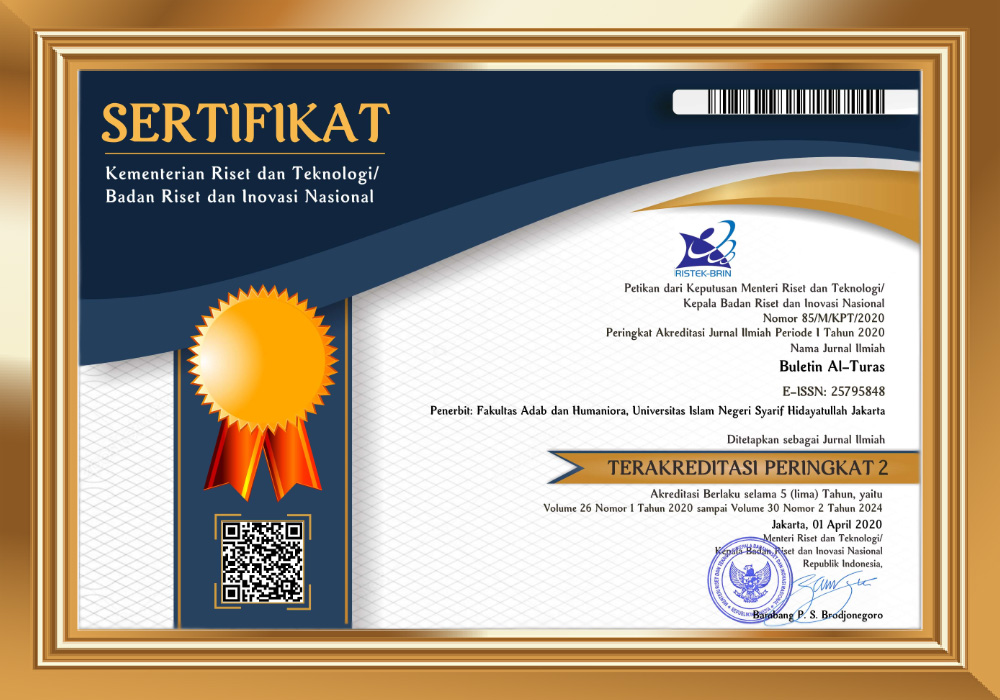The Relation of Contentment and Mental Health in al-Hikam
Abstract
Purpose
This study aimed to explore the relationship of contentment values with mental health theory in enhancing emotional stability and reducing reliance on materialistic ambitions that were often the cause of psychological instability.
Method
Using a qualitative descriptive approach, this study objectively analyzes the book al-H{ikam by Ibn Atha’ilah, using a qualitative descriptive approach. Primary data was obtained from the text of al-H{ikam, while secondary data was obtained from literature related to mental health and spirituality.
Results/findings
Research findings suggest that contentment helps individuals reduce psychological distress by promoting mental resilience through the mechanisms of self-acceptance and gratitude. The practice also provides sustained inner peace, even under stressful circumstances.
Conclusion
This research concludes that contentment has the potential to be integrated into modern mental health approaches, both in a spiritual and multicultural context. By translating the values of contentment into the language of modern psychology, the concept becomes accessible to a wider audience. These findings pave the way for the development of innovative and relevant spirituality-based interventions to address global mental health challenges.
Keywords
References
Abbink, J. (2023). Understanding “Secularism.” Secular Studies, 5(1), 1–7. https://doi.org/10.1163/25892525-bja10043
Afiani, V. Z., & Haririe, M. R. (2024). Sufism and Mental Health: Application of Sufism Principles in Mental Well-Being. Vivia Zahira A. & Muhammad Ruhiyat H.) |103 Journal of Sufism and Psychotherapy, 4(1), 2797–779.
Bhugra, D., Till, A., & Sartorius, N. (2013). What is mental health? International Journal of Social Psychiatry, 59(1), 3–4. https://doi.org/10.1177/0020764012463315
Bronfenbrenner, U. (1979). The Ecology of Human Development: Experiments by Nature and Design. Harvard University Press. https://doi.org/https://doi.org/10.2307/j.ctv26071r6
Chittick, Wi. C. (2001). The Heart of Islamic Philosophy. In Oxford University Press (Vol. 11, Issue 1). Oxford University Press. http://scioteca.caf.com/bitstream/handle/123456789/1091/RED2017-Eng-8ene.pdf?sequence=12&isAllowed=y%0Ahttp://dx.doi.org/10.1016/j.regsciurbeco.2008.06.005%0Ahttps://www.researchgate.net/publication/305320484_SISTEM_PEMBETUNGAN_TERPUSAT_STRATEGI_MELESTARI
Conway, R. (2012). Review of “Flourish: A new understanding of happiness and well-being—and how to achieve them.” The Journal of Positive Psychology, 7(2), 159–161. 10.1080/17439760.2011.614831%5Cnhttp://ezproxy.umsl.edu/login?url=http://search.ebscohost.com/login.aspx?direct=true&db=psyh&AN=2012-07208-008&site=ehost-live&scope=site%5Cnr.conway4@nuigalway.ie
Fitriya, E., Ma, S., & Hikam, A. (2024). Tasawuf dalam Perspektif Psikologi: Harmoni Spiritual dan Kesehatan Mental. Alhikam Journal of Multidisciplinary Islamic Education, 5(2), 291–306.
Goleman, D. (2006). Emotional Intelligence. Bantam Dell.
Guefara, R. L. (2024). Tasawuf Offers A Rich, Spiritual Approach To Understanding and Nurturing Mental Health. World Journal of Islamic Learning and …, 1(2). https://international.aripafi.or.id/index.php/WJILT/article/view/29%0Ahttps://international.aripafi.or.id/index.php/WJILT/article/download/29/41
Halim, A. A. Al, Kamal, N., & Mohammed, W. (2024). Sufism as therapy: Psychological problems of modern society. Advances in Humanities and Contemporary Studies, 5(1), 64–69.
Hill, P. C., & Pargament, K. I. (2003). Advances in the Conceptualization and Measurement of Religion and Spirituality: Implications for Physical and Mental Health Research. American Psychologist, 58(1), 64–74. https://doi.org/10.1037/0003-066X.58.1.64
Ibrahim, M. I. (1939). Syarhu Kitab al Hikam. Mushtafa al Babi al Halbi wa Awladihi.
Irham, M. I. (2023). Sufism Psychotherapy: Hudur al-Qalb Method For Mental Health. Journal of Asian Wisdom and Islamic Behavior, 1(2), 94–103. https://doi.org/10.59371/jawab.v1i2.58
Kamaluddin, R. T., Hafidhuddin, D., & Alim, A. (2024). Tazkiyatun Nafs dalam Al- Qur’ an & relevansinya terhadap terapi spiritual pada era disrupsi ِّ َّ. c, 46–72.
Kessler, R. C. (1997). the Effects of Stressful Life. Annual Review of Psychology, 191–214.
Koenig, H. G., King, D. E., & Carson, V. B. (2012). Handbook of religion and health (2nd ed.). Oxford University Press.
Maksum, M. (2024). Peran Tasawuf dalam menggugaj Spiritualitas di Era Digital (Studi Kasu Dakwah KH. Abdul Syakur Yasin Di Channel YouTube)." PhD diss., , 2024. Institut Al Fithrah (IAF) Surabaya.
Nasr, S. H. (2002). The Heart of Islam Enduring Values for Humanity Introduction to Islam. Perfect Bound.
Nizamie, S. H., Ul Haq Katshu, M. Z., & Uvais, N. A. (2013). Sufism and mental health. Indian Journal of Psychiatry, 55(SPEC. SUPPL.), 215–223. https://doi.org/10.4103/0019-5545.105535
Pargament, K. I. (1997). The psychology of religion and coping: theory, research, practice. Guilford Press.
Qutb, S. (2004). Fī dhilāl al- Qur’an. Dār al-Shuruq.
Ramadhani, F., & Dinata., K. I. (2024). Membangun Keseimbangan antara Tasawuf dan Perkembangan Teknologi di Era Digitalisasi. UInScof, 2(1), 196–205.
Rusdi, R. A., & Khodijah. (2024). Qanā‘ah al-Ghazālī sebagai Landasan Stabilitas Mental: Pendekatan Holistik-Psikosufistik dengan Teknik Pernapasan 4-7-8. Journal of Ushuluddin and Islamic Thought, 2(1).
Tsarnubi, A. M. al. (1989). Syarhu al Hikam al ’Athaiyyah. Daru Ibnu Katsir.
Wahid, A., & Maskhuroh, L. (2024). Tasawuf dalam Era Digital: Menjaga Kesadaran Spiritual di Tengah Arus Teknologi. ILJ: Islamic Learning Journal, 2(1), 55–73. http://scioteca.caf.com/bitstream/handle/123456789/1091/RED2017-Eng-8ene.pdf?sequence=12&isAllowed=y%0Ahttp://dx.doi.org/10.1016/j.regsciurbeco.2008.06.005%0Ahttps://www.researchgate.net/publication/305320484_SISTEM_PEMBETUNGAN_TERPUSAT_STRATEGI_MELESTARI
Waluyojati, M. P., & Swari, D. I. (2024). Mutiara : Jurnal Penelitian dan Karya Ilmiah Peran Psikologi Tasawuf Mengenai Kesehatan Mental dan Spiritualitas Generasi Z Pada Era Digital. Mutiara : Jurnal Penelitian Dan Karya Ilmiah, 2(4), 1–11.
DOI: 10.15408/bat.v31i1.44788
Refbacks
- There are currently no refbacks.
Copyright (c) 2025 Devi Suci Windariyah

This work is licensed under a Creative Commons Attribution-ShareAlike 4.0 International License.







